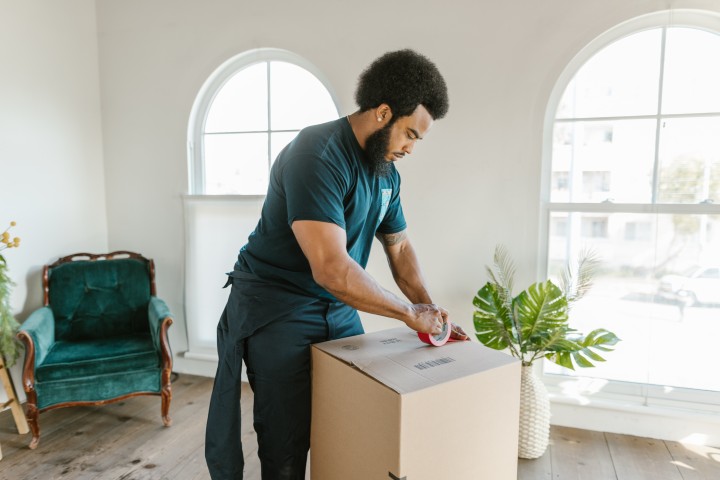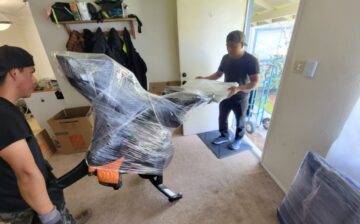Are you planning a move? Whether you’ve just landed your dream job in another state or found the perfect home in a different city, you’ve taken an enormous step forward.
Now, you just have to get everything packed up and ready to move. Packing is the most time-consuming part of moving. So the natural question is, how soon should you start?
This post will give some tips for packing your home for a move. It will provide tips for when and how to start packing and describe common mistakes.
The average American moves 11 times in their lifetime. You may find this information helpful if you’re getting ready for a move or expect to move soon.
When Should You Start Packing?
Although it depends on how far you’re moving and how much you have to pack, the general advice is to start the packing process as soon as you’ve decided to move.
Sorting out your belongings, deciding what to take with you, and preparing moving boxes and containers for everything… all of this takes time. Moving experts suggest starting at least three weeks before your expected move date; some advise beginning eight weeks before.
How Should You Start Packing?
The first step is to declutter. Go through your closets, attic, basement, garage, and storage rooms. Decide what to keep and what to get rid of. Items you haven’t used for at least a year and cannot guarantee you will use again and that have no sentimental value are probably safe to get rid of. Then put things in separate boxes to sell, donate, or throw away. Remember that the more items you move, the higher the cost.
Also, consider the home you’re moving into. Will your bedroom set fit in your new bedroom? Is your new living room big enough for your eight-piece sectional? Can your garden equipment and power tools fit in your new garage? If there are any items you won’t need or that aren’t suited for your new home, plan to get rid of them before you move.
Also, make sure you can move furniture or other large items around your home without damaging your home or the objects. If you’re unsure, consider hiring professional movers who have the training, experience, and equipment.
If you have enough items to sell that might be of value to others, consider holding a moving sale or garage sale. This can help you raise money for your move. By starting early enough, you allow time to schedule the sale and to donate whatever doesn’t get sold.
Once you’ve determined what items will move with you, you can obtain packing boxes and supplies. There are places you can easily find free, previously used boxes. These will be fine for less fragile items like books and office supplies.
Packing is time-consuming and can be physically tiring. That’s why you should start early and spread it out over several weeks by packing at least a couple of boxes daily. Experts say it takes about an hour to pack up each room. Packing will take longer than you think, and the later you start, the more stressful and disorganized your move will be.
You can start by packing up the least important items. Start by packing things in your storage areas that you don’t use regularly. Box up these items first. Finish your packing process with your kitchen, bathroom, and bedroom furnishings.
You should also consider having an “essentials box” that contains important documents, clothes, and toiletry items you’ll need in the first week after your move. Bring this with you so you won’t have to search through boxes looking for your toothbrush or bath towel.
A labeling system is essential to track each box’s contents. This will be very handy when you have to unpack later.
Packing Mistakes
Here are some common packing mistakes that people make, according to NYC professional movers.
Using Inappropriate Packing Materials
Although you can get free moving boxes in different places, using the right boxes and materials for moving your household goods is essential. Moving boxes come in standard sizes, enabling them to be stacked against each other for loading and transport. A haphazard combination of old vegetable bins and Amazon shipping boxes is harder to stack and will allow things to move around and possibly fall inside the truck during transport.
Also, ensure the box can hold the weight of the items you want to pack. The old boxes you found in the supermarket dumpster might not be sturdy enough, and things might fall out the bottom while you’re carrying them.
Many people use trash bags for last-minute items. But trash bags don’t stack well inside the moving truck and don’t protect the household goods inside them. When things fall on top of the bag, the contents are vulnerable to being crushed. Use moving boxes instead.
Likewise, plastic or canvas tote bags are convenient for everyday loads but aren’t designed for moving and can break under large amounts of weight.
Packing Boxes Incorrectly
Leaving empty space inside boxes allows things to move and bang into each other, possibly causing damage. Fill open spaces with packing peanuts or paper. Also, heavier items should go in the bottom of the box, wrapped in bubble wrap, and lighter items on top. More fragile items like dishes, glasses, and pictures in frames should be packed in specialized boxes or wrapped in multiple layers and packed upright on their edge.
The heavier boxes and belongings should be loaded at the bottom of the truck, with the lighter things on top. This prevents the more lightweight items from being crushed.
Experts recommend using pressure-sensitive 2-inch-wide packing tape. Seal carton bottoms with three or four layers of tape and tops with two or three layers. Use two or three layers of packing paper or peanuts at the bottom of the box for cushioning. Use additional layers between items and on top.
Mixing Items Inappropriately
Electronics like laptops and tablets can be destroyed or damaged when put next to magnetic fields from speakers or electric motors. Food should never be put near toxic cleaners.
Liquids including water, drinks, and cleaners cannot be transported. Even a small bottle of nail polish remover can endanger your property or that of another customer.
Packing Too Much in Each Box
If a box weighs more than about 50 pounds, it can be dangerous to lift and carry. Divide heavier items like books, documents, and canned food among several, smaller boxes.
Remember that the moving company has limited liability for boxes and items you packed yourself. The mover is only responsible for the property it packed. If you have valuable or irreplaceable items like family heirlooms, a record collection, or musical instruments, consider having these packed and transported by professionals who are able to pack and transport them securely. If anything is lost or damaged, the mover is liable and their insurance will cover the loss.
By starting your packing early and following the tips in this post, you’ll help ensure a safe and successful move.
We hope you found this post, When to Start Packing for a Move useful. For more great information, check out our post Packing when moving: A thorough room-by-room guide.
Have Experience in the Moving Industry? Want an Additional Income Stream? Work With All Around Moving!
Partner with All Around Moving & join the Work With Us program. We will help you make money arranging professional moving services, by establishing your own moving consultant business operation. Click here to learn more.






